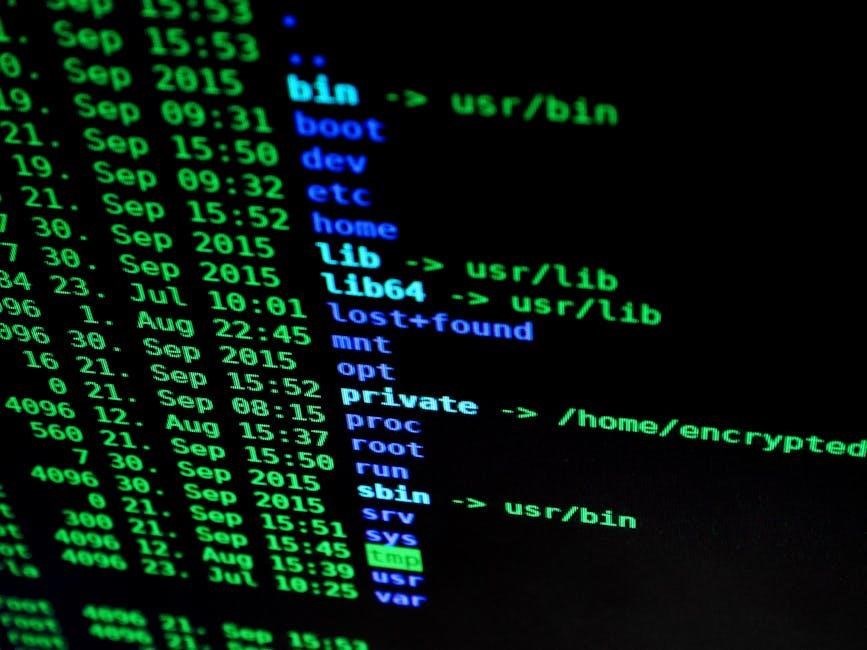Overview of the International Plumbing Code (IPC)
The International Plumbing Code (IPC) serves as a model code, establishing minimum regulations for plumbing systems. It covers design, installation, and maintenance, ensuring public health and safety in various building types, excluding specific residential structures.
Purpose and Scope of the IPC
The International Plumbing Code (IPC) is a comprehensive model code designed to safeguard public health, safety, and welfare by regulating the design, installation, and maintenance of plumbing systems. Its primary purpose is to establish minimum requirements for plumbing facilities, encompassing fixtures, water heaters, water supply, and distribution systems, sanitary drainage, and storm drainage. The IPC applies to various building types, excluding detached one- and two-family dwellings and townhouses not exceeding three stories.
The code’s scope extends to both prescriptive and performance-related provisions, allowing for the acceptance of new materials and innovative plumbing designs. It provides flexibility while ensuring compliance with established safety standards. The IPC aims to provide a uniform set of regulations that can be adopted and enforced by jurisdictions worldwide, promoting consistency and efficiency in plumbing practices.
Governing Plumbing Systems
The International Plumbing Code (IPC) meticulously governs plumbing systems within its scope, setting forth regulations for various aspects of their design, installation, and maintenance. It addresses crucial elements such as water supply and distribution, ensuring safe and efficient delivery of potable water throughout a building. The IPC also provides detailed guidelines for sanitary drainage systems, effectively managing wastewater and preventing contamination.
Furthermore, the code covers venting systems, crucial for maintaining proper air circulation and preventing sewer gases from entering buildings. It includes provisions for plumbing fixtures, dictating standards for their installation and performance. Additionally, the IPC addresses specialized systems like medical gas and vacuum systems, ensuring their safe and reliable operation. By comprehensively regulating these components, the IPC ensures that plumbing systems function effectively while protecting public health and safety.

Availability of the IPC
The International Plumbing Code (IPC) is accessible through various channels. The ICC’s website offers options to view the code. Users can also obtain the IPC in PDF format for convenient access and offline use.
Free Online Access
Accessing the International Plumbing Code (IPC) online for free is made possible through the International Code Council (ICC) website. The ICC provides a platform where users can view the complete code without charge, promoting widespread accessibility. This free access is crucial for code officials, architects, engineers, and construction professionals who need to consult the IPC regularly.
The online version of the IPC allows users to navigate through the code, search for specific sections, and review the regulations. This accessibility ensures that stakeholders can easily stay informed about the latest plumbing standards. Moreover, it supports the ICC’s mission to provide safe, sustainable, and affordable building solutions globally. The digital format enhances convenience.
PDF Download Options
For users seeking offline access or archival purposes, the International Plumbing Code (IPC) offers PDF download options. While direct free downloads of the complete IPC might be limited due to copyright restrictions, the ICC provides avenues to purchase and download the code in PDF format. Purchasing the PDF version grants users the ability to have a digital copy that can be accessed anytime, anywhere, without needing an internet connection.
Additionally, some jurisdictions or organizations may offer licensed PDFs to their members or employees. These downloaded versions retain the full functionality of the printed code, including search capabilities and bookmarking features. Ensuring that users have reliable access to the IPC.

Key Features of the IPC
The IPC uniquely combines prescriptive and performance-related provisions. This enables flexibility in design and installation, allowing for both traditional methods and innovative approaches that meet defined performance criteria, promoting advancements in plumbing practices.
Prescriptive and Performance-Related Provisions
The International Plumbing Code (IPC) distinguishes itself by integrating both prescriptive and performance-based approaches to plumbing regulations. Prescriptive provisions offer clear, specific guidelines for plumbing system design and installation, ensuring straightforward compliance. These are the ‘how-to’ instructions of the code.
However, recognizing the need for innovation, the IPC also incorporates performance-related provisions. These provisions focus on the desired outcome or functionality of a plumbing system, allowing flexibility in design and material selection as long as the system meets the specified performance criteria; This allows engineers and contractors to adopt new technologies and methods.
This dual approach ensures both safety and encourages advancements in plumbing practices. By offering both detailed instructions and the freedom to innovate, the IPC fosters a balance between established methods and cutting-edge solutions, adapting to the ever-evolving landscape of plumbing technology while upholding stringent safety standards.
Acceptance of New Materials and Designs
A key feature of the International Plumbing Code (IPC) is its proactive stance on accepting new materials and innovative plumbing designs. The code is founded on principles that enable the use of cutting-edge technologies and methods, provided they meet the required performance standards. This promotes progress within the plumbing industry.
The IPC’s flexibility allows for the evaluation and integration of novel materials and designs that may not be explicitly covered by prescriptive requirements. This encourages manufacturers and designers to develop more efficient and sustainable plumbing solutions.
To ensure safety and reliability, the IPC establishes rigorous evaluation processes for new materials and designs. These processes involve thorough testing and assessment to verify that the proposed innovations meet or exceed the code’s performance objectives. This approach keeps the code up-to-date.

Editions of the IPC
The International Plumbing Code (IPC) is updated regularly to reflect advancements in plumbing technology and safety standards. Key editions include the 2018, 2021, and 2024 versions, each incorporating revisions.
2018 IPC
The 2018 International Plumbing Code (IPC) aims to safeguard public health and safety by regulating the design, installation, and maintenance of plumbing systems. It sets forth requirements for plumbing systems in buildings, excluding detached one- and two-family homes and townhouses under three stories. The code addresses plumbing fixtures, water heaters, sanitary and storm drainage, and water supply systems.
The 2018 IPC emphasizes both prescriptive and performance-based approaches, allowing for innovative materials and designs. This edition references several standards and is updated to reflect modern plumbing practices. It’s available in digital and print formats.
2021 IPC
The 2021 International Plumbing Code (IPC) establishes the minimum regulations for plumbing facilities, focusing on fixtures, water heaters, and water supply and distribution systems. It also covers sanitary and storm drainage systems. This edition builds upon previous versions, incorporating updates and revisions to reflect current plumbing practices and technologies.
The 2021 IPC emphasizes both prescriptive and performance-related provisions, allowing for the acceptance of new materials and designs. It provides clear guidelines for plumbing systems in various buildings, excluding certain residential structures. The code is available in both print and digital formats.
2024 IPC
The 2024 International Plumbing Code (IPC) represents the latest edition in a series of comprehensive plumbing regulations. It builds upon previous versions, incorporating updates and revisions to reflect advancements in plumbing technology and practices. This edition aims to ensure safe and efficient plumbing systems in various building types.
The 2024 IPC focuses on minimum requirements for plumbing facilities, including fixtures, water heaters, water supply and distribution, sanitary drainage, and storm drainage. It emphasizes both prescriptive and performance-based approaches, allowing for flexibility in design and material selection. It is available for purchase and digital access through the ICC.

Adoption and Use
The International Plumbing Code (IPC) serves as a model code, applicable to all building types except detached one- and two-family dwellings and townhouses not more than three stories above grade in height.
Model Code for Various Buildings
The International Plumbing Code (IPC) is designed as a comprehensive model code, offering regulations for plumbing systems in diverse building types. Its application extends to nearly all structures, with specific exceptions carved out for detached one- and two-family dwellings, as well as townhouses that do not exceed three stories in height above grade. This broad applicability underscores the IPC’s role in establishing a consistent baseline for plumbing safety and efficiency across a wide spectrum of construction projects. By providing a standardized framework, the IPC facilitates uniformity in plumbing practices, promoting safer and more reliable systems within the built environment. This widespread adoption ensures that plumbing installations adhere to a recognized set of standards, minimizing potential risks and enhancing the overall quality of construction.
Jurisdictional Adoption
Jurisdictions across the United States, and even internationally, frequently adopt the International Plumbing Code (IPC) as the foundation for their local plumbing regulations. This adoption process often involves incorporating the IPC directly or adapting it to suit specific local needs and conditions. By adopting the IPC, jurisdictions benefit from a well-established and regularly updated code that reflects the latest advancements in plumbing technology and safety practices. The IPC’s widespread recognition and acceptance streamline the regulatory landscape for builders and contractors, promoting consistency and simplifying compliance efforts. Moreover, adopting the IPC allows jurisdictions to leverage the expertise and resources of the International Code Council (ICC), ensuring that their plumbing regulations remain current and effective in safeguarding public health and safety. This collaborative approach fosters a more standardized and reliable plumbing infrastructure across various regions.
Resources and Support
The International Code Council (ICC) website serves as a central hub for resources related to the International Plumbing Code, offering access to the code itself, updates, interpretations, and various support materials for users.
ICC Website
The International Code Council (ICC) website (www.iccsafe.org) is the primary source for information and resources related to the International Plumbing Code (IPC). The website offers various resources including the complete code text, often available in a read-only format for free viewing. Users can purchase premium subscriptions to unlock additional features such as printing and advanced search capabilities.
The ICC website also provides access to code commentaries, which offer interpretations and explanations of the code provisions. Additionally, the site features technical articles, updates on code changes, and registration options for code users. It also offers resources for understanding and implementing the latest editions of the IPC.
Furthermore, the ICC website serves as a platform for purchasing printed copies of the IPC and other related publications. It is a valuable tool for architects, engineers, contractors, and code officials seeking comprehensive information and support for navigating the IPC and ensuring compliance with plumbing regulations.
Code Updates and Registration
Staying current with the International Plumbing Code (IPC) requires regular attention to code updates and revisions. The International Code Council (ICC) provides avenues for users to receive updates, ensuring they are aware of the latest changes in regulations and standards. Registering IPC code books through the ICC website (www.iccsafe.org/CodesPlus) often grants access to free updates, technical articles, and excerpts of code references.
Registration allows users to validate the authenticity of their code books and receive incentives. Subscribing to premium digital code platforms unlocks enhanced features, including notifications of code changes. The ICC also offers resources and training programs to help professionals understand and implement the updates effectively.
These resources are essential for architects, engineers, and contractors to maintain compliance and implement the latest best practices in plumbing system design and installation. Regularly checking for updates and participating in ICC programs ensures that professionals remain informed and capable of applying the most current IPC requirements.
